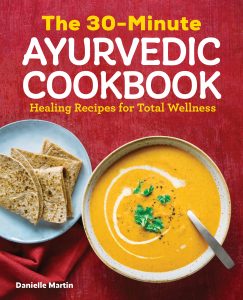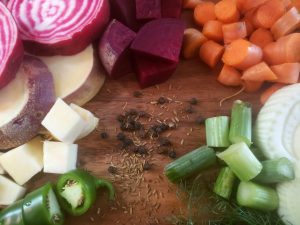 One of my favorite rituals for the fall is sipping on teas and broths to keep my body warm, my mind calm, and my soul soothed. Not to mention the amazing aroma that will fill your home as you steep these cold-weather essentials. Here is a super flavorful, super healing veggie broth recipe that is perfect for keeping you healthy and balanced throughout the fall and winter seasons. It is filled with grounding root veggies, nutrient-rich greens, and a plethora of flavors to create a sweet, savory, and spicy broth for your everyday enjoyment.
One of my favorite rituals for the fall is sipping on teas and broths to keep my body warm, my mind calm, and my soul soothed. Not to mention the amazing aroma that will fill your home as you steep these cold-weather essentials. Here is a super flavorful, super healing veggie broth recipe that is perfect for keeping you healthy and balanced throughout the fall and winter seasons. It is filled with grounding root veggies, nutrient-rich greens, and a plethora of flavors to create a sweet, savory, and spicy broth for your everyday enjoyment.
This delicious broth recipe is made from many seasonal veggies of the fall months. In fact, I visited my beloved local farmer’s market for inspiration to get all of these amazing vegetables. I chose the beets and carrots for their amazing color, sweet flavor, and incredible nutrient content; the fresh fennel for its unique taste and unbeatable digestion-enhancing properties; celery for its powerful cleansing abilities; and onion, garlic, and jalapeño for their detoxifying, immune-boosting, and flavorful qualities.
How Can You Enjoy Veggie Broth?
You can easily make this veggie broth a regular part of your daily regimen. I often enjoy it between meals as a healthy snack. Here are some more ideas for you:
- Drink as a hydrating, cleansing, digestion-boosting drink throughout your day
- Drink during cold, fever, and flu to flush your system, keep you hydrated, and boost your immunity
- Drink as a light meal when you have overeaten or your appetite is dull
- Drink as a light dinner, especially if it is too late to eat a big meal
- Drink as a healthy late-night snack to keep your hunger (and unhealthy cravings) down
- Use it as a base for your favorite Kitchari, dal, or soup recipe to improve flavor and nutrient value
- Enhance the flavor of your rice or quinoa by using this broth as a base (simply replace the water in equal amounts)
What Makes this Veggie Broth So Super?
All veggie broths are not the same in taste, quality, and health properties. Here are a few reasons this recipe stands out over the rest:
- Contains all six tastes of Ayurveda, making it more balanced and healing (read more on the six tastes here)
- Contains a wealth of antioxidants, vitamins, and minerals, in an easy-to-absorb form
- Beneficial for digestion due to additions such as ginger, turmeric, freshly ground black pepper, fennel, and fresh lemon juice
- Uses seasonal vegetables of the fall and winter months
- Simple to make
- Everything is better homemade!
- Fresher and healthier than store bought varieties
- Less salt than many store bought varieties
- Easy to modify if you do not have all of the ingredients at hand (see my list of suggestions below)
- Easy to modify for your dosha type (see recipe)
- Delicious, versatile, and easy to make a regular part of your routine
If you are looking at the ingredient list, but cannot find the specific veggies in your local market, do not fret! There are countless variations and replacements that can be equally as delicious and healthy. Here are some ideas for you:
Tasty Variations
- Sweet potato is a great replacement for the rutabaga or beets
- Parsnip is a great replacement for the rutabaga or carrots
- Whole fennel seed (about 2 tablespoons) can be used if fresh fennel cannot be found
- Lime is a great substitute for the lemon (and more cooling for Pitta types or during the hot months)
- Chard, spinach, or dandelion greens are great replacements for the beet greens
- Serrano peppers are great replacements for the jalapeños
- If you are looking to make your broth less spicy, discard the inners of the jalapeño and just add the outside layer for some flavor without as much spice; omit the cayenne pepper as well

Super Veggie Broth Recipe
Click here for a printable copy of this recipe.
- Doshic Effect: Vata ↓, Pitta ↓*, Kapha ↓
- Makes: 12 to 16 cups
- Prep Time: 30 minutes
- Slow Cooker Time: 12 to 16 hours on low (best!) or 6 to 8 hours on high
*Please follow the recommended modifications to make this recipe more suitable for Pitta.
Materials
- Slow Cooker (aka crock pot); you can alternatively use a large, stove top stock pot
- Cutting board and knife
- Measuring cups and spoons
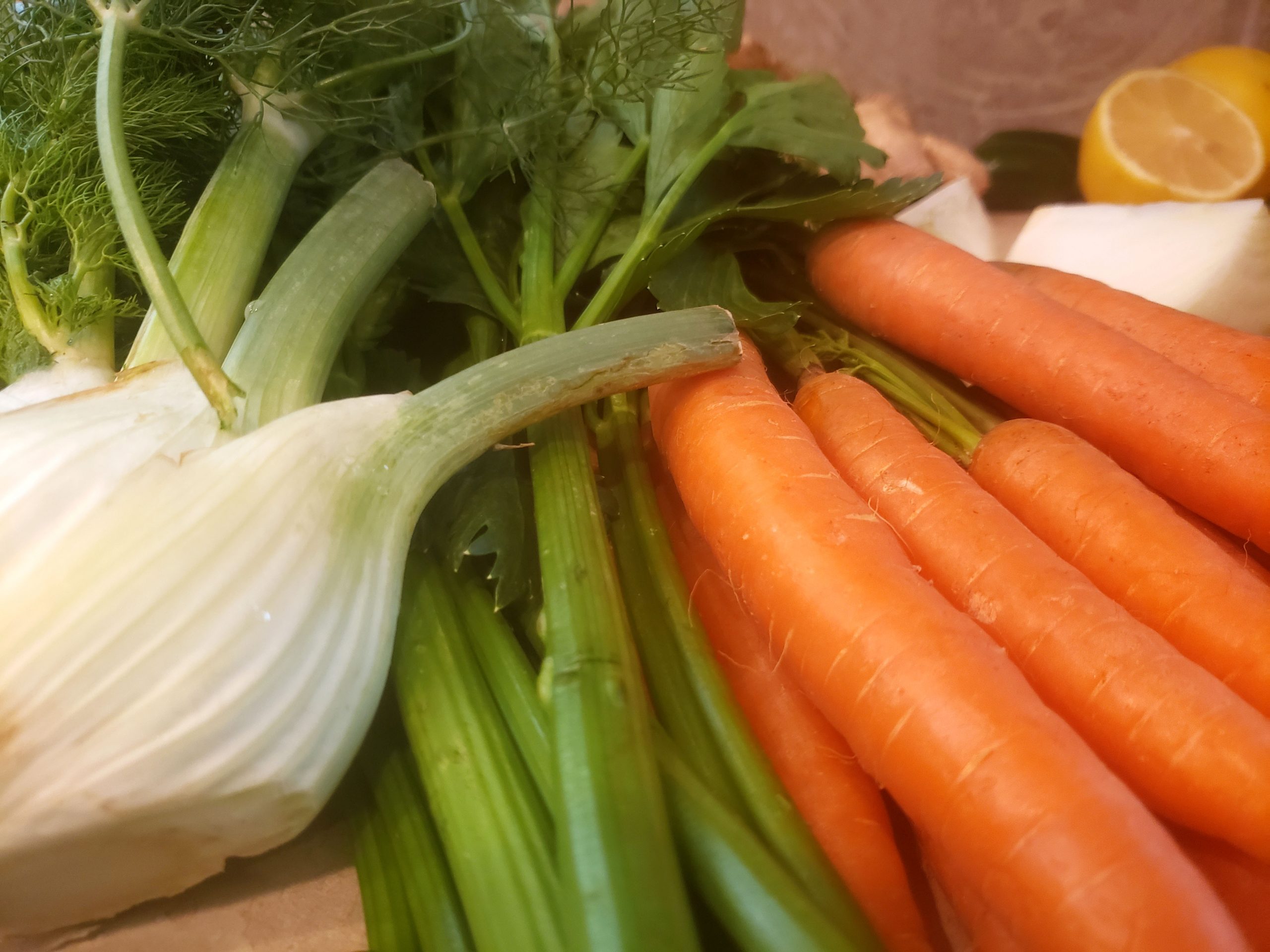
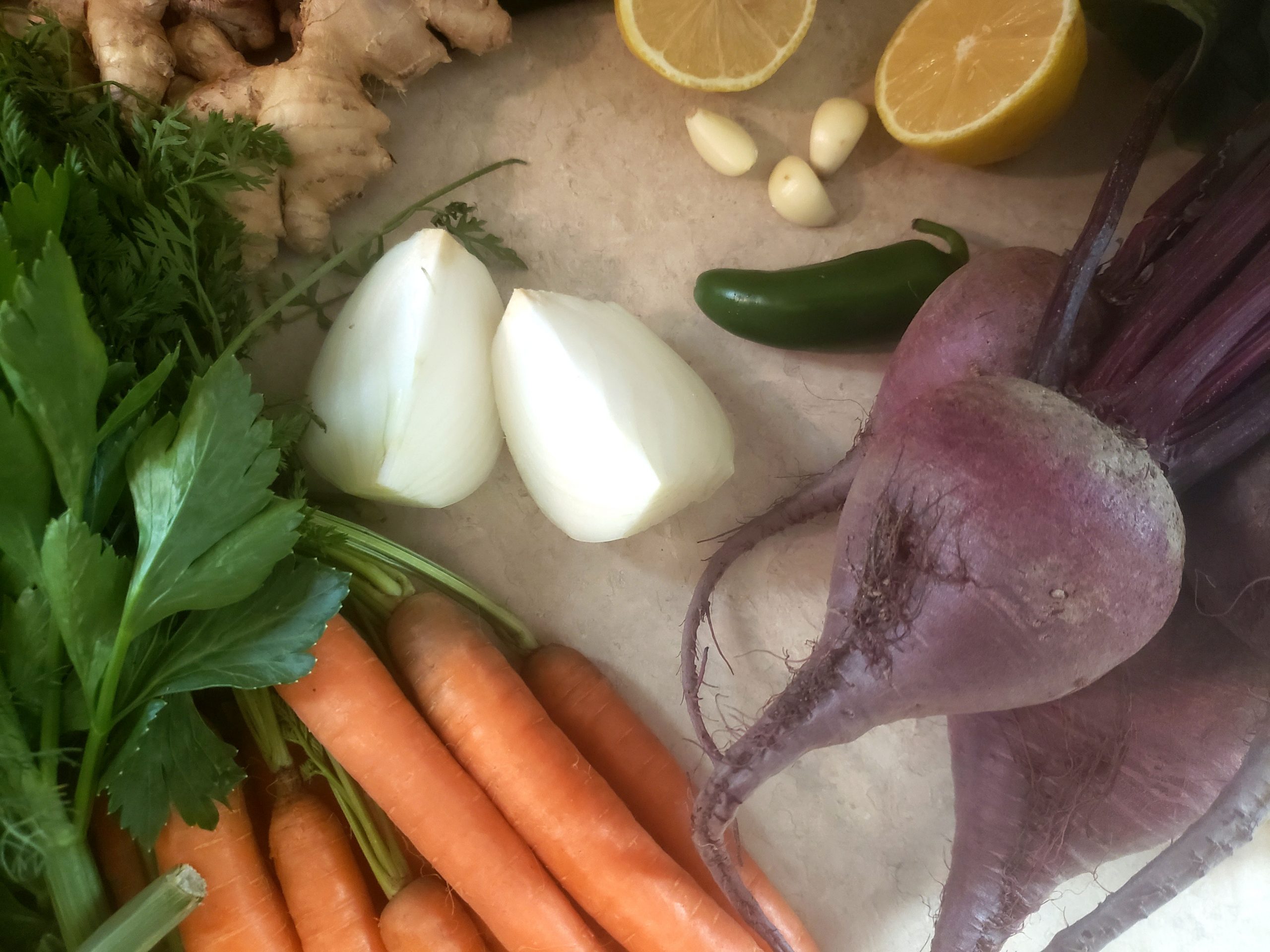
Ingredients
- 12 to 16 cups water (depending on the size of your crock pot)
- 3 medium beets (about 3 cups)
- 1 medium rutabaga (about 1 cup)
- Fresh fennel (about 1½ to 2 cups), all parts can be used!
- 5 medium celery stalks (about 2 cups)
- 3 large carrots (about 1½ cups)
- Beet greens (about 2 cups packed)
- 2 medium jalapeños (optional, omit for Pitta)
- 1 medium yellow onion (about 2 cups)
- 3 medium garlic cloves (optional, use 1 clove or omit for Pitta)
- 3” to 4” cube fresh ginger, finely chopped or grated (replace with 1 to 2 teaspoons of ginger powder)
- 2” cube fresh turmeric, finely chopped or grated (replace with 1 teaspoon turmeric powder)
- 1 teaspoon black peppercorns, freshly ground
- 1½ teaspoons whole cumin seed (grind fresh for best flavor!)
- ¾ teaspoon pink Himalayan or mineral salt (substitute with sea salt)
- ⅛ teaspoon cayenne pepper (optional, omit for Pitta)
- 2 to 4 tablespoons olive oil (use 1 to 2 tablespoons for Kapha)
- 1½ to 2 lemons, freshly juiced (use 2 limes for Pitta)
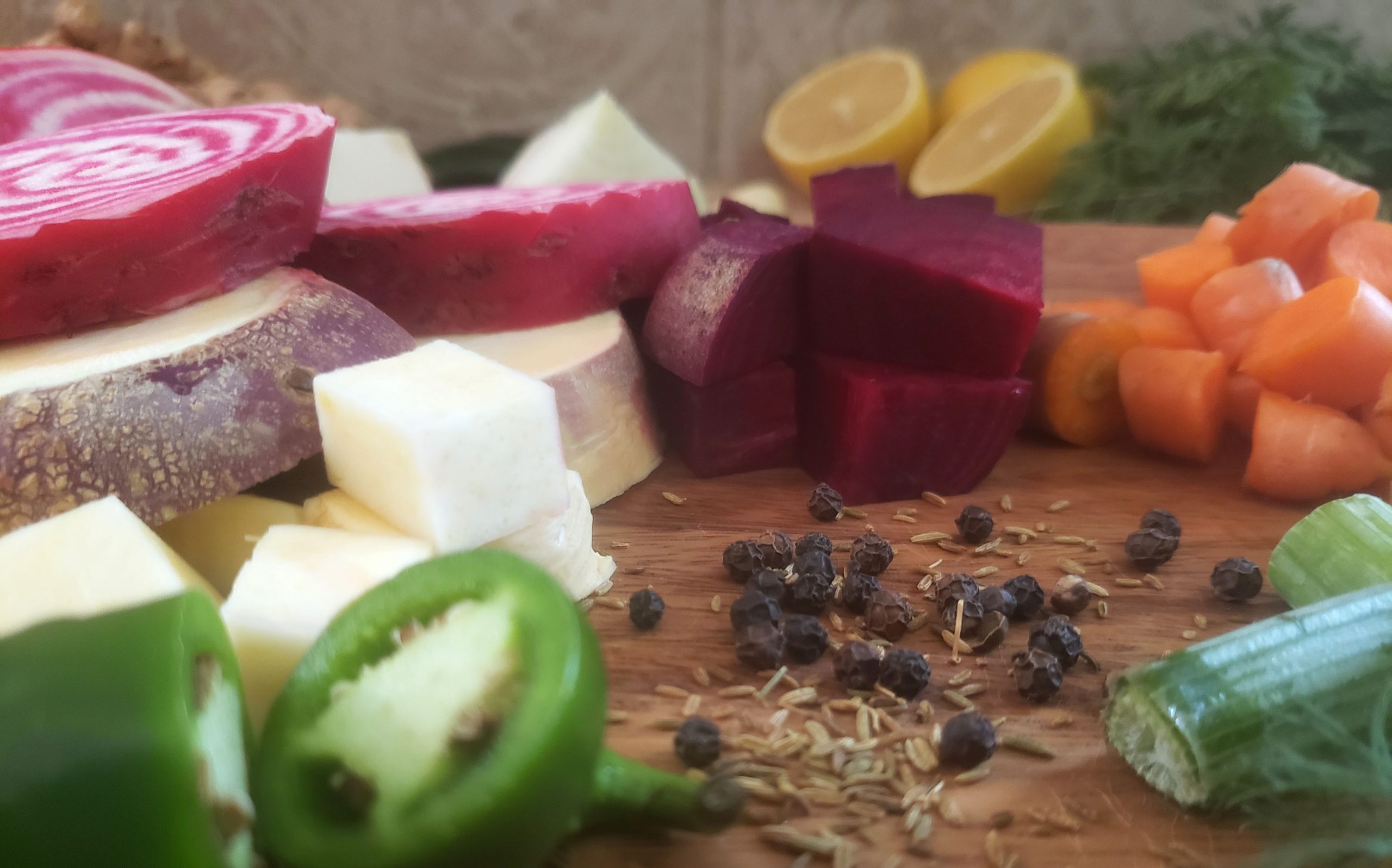

Directions
Click here for a printable copy of this recipe.
1. Add the water to your crock pot, making sure you have at least 3 inches of space left for the ingredients. Turn the pot on to a low setting (or high if time is short).
2. Carefully wash and coarsely chop the beets, rutabaga, fennel, celery, carrots, beet greens, and jalapeño (if using). Add them to the crock pot.
3. Peel and chop the onion and garlic (if using). Add them to the crock pot.
4. Finely chop or grate the fresh ginger and turmeric. Add them to the crock pot.
NOTE: Fresh is best, but add in the dried powder if these fresh roots are not available.
5. Measure out and grind (optional, but recommended) the black pepper and cumin seed. Add them to the crock pot.
6. Add the salt and cayenne pepper (if using) to the pot.
7. Stir all of the ingredients until everything has been combined well.
8. Place the top on the crock pot and continue to cook on low for 12 to 16 hours. If time is short, cook on high for at least 8 hours.
NOTE: If a crock pot is not available, you can alternatively cook this broth in a large stock pot on the stove for 12 to 16 hours over a low heat. For this, I would suggest to get the temperature up by heating the water to just below a boil and then turning the heat down to its lowest point.
9. Stir every 2 to 3 hours (when possible).
10. Once the broth has been fully steeped, strain the liquid into a large pan using a large mesh strainer. I like to use a glass measuring cup to scoop the soup out and pour it into the strainer to avoid a big mess.
11. Once the liquid has been strained, discard the cooked ingredients in the compost or save them to share with your furry friend. They are still rich in fiber and may have a little flavor left.
12. Add the fresh lemon juice and olive oil to the strained broth. Stir well.
13. Sip and enjoy! Use it in your favorite Kitchari, rice, quinoa, or dal recipe; drink it regularly during illness or times of cleansing; or simply enjoy it as a warm, soothing, and delicious drink throughout the fall and wintertime!
STORAGE TIP: This broth will stay vital for up to 5 days. Store any extra in some air tight glass jars in your refrigerator. Only reheat the amount needed and never reheat more than once!
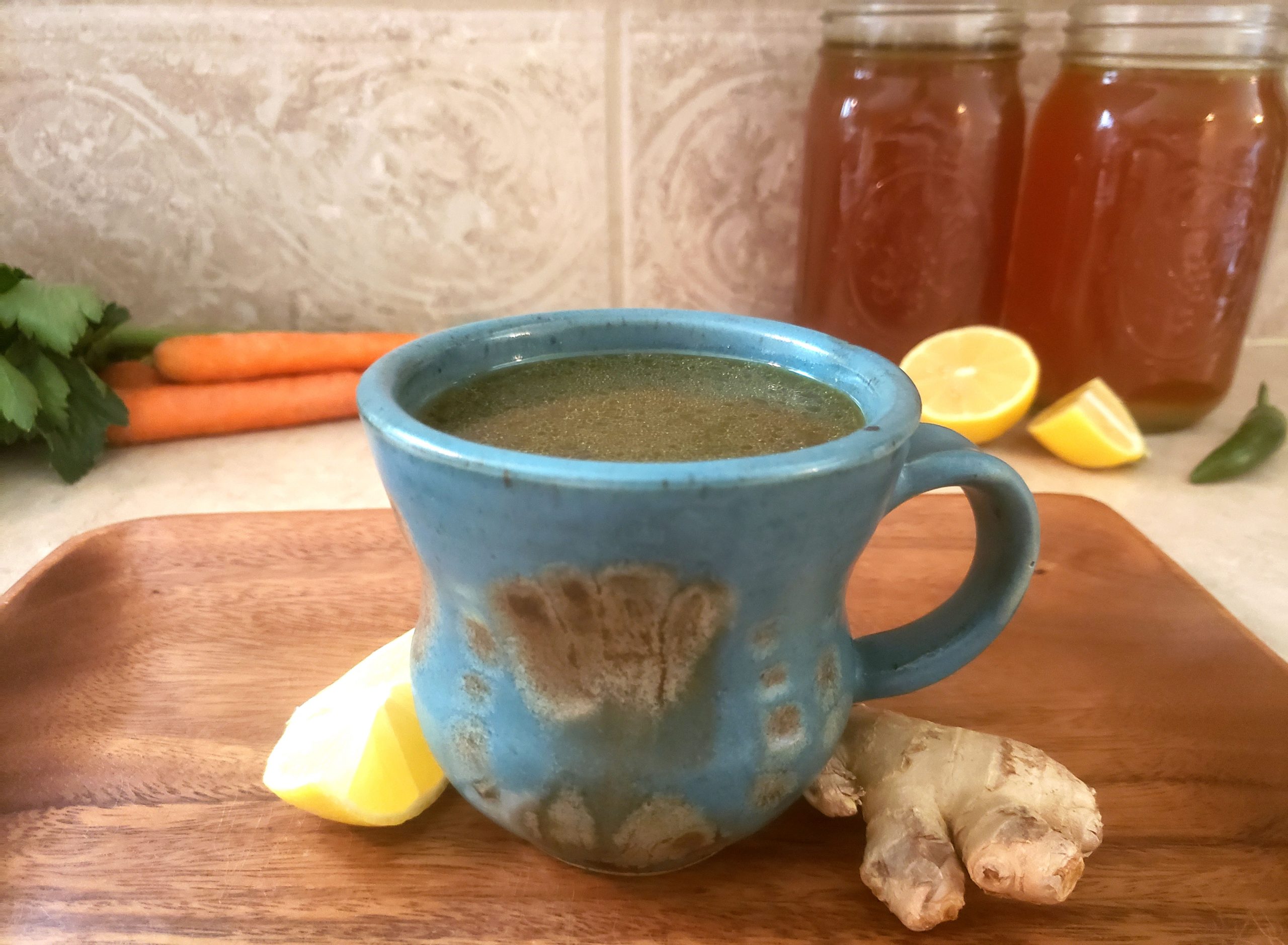
Discover more healing recipes with my 30-Minute Ayurvedic Cookbook!


